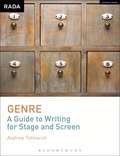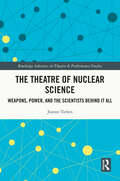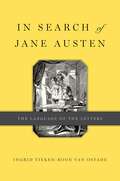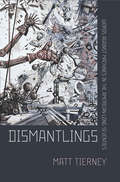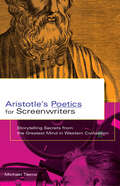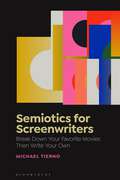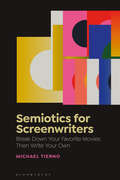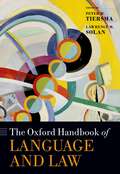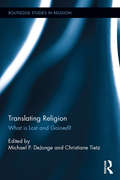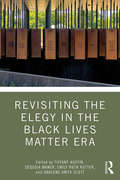- Table View
- List View
South-Asian Fiction in English: Contemporary Transformations
by Alex TickellThis collection offers an essential, structured survey of contemporary fictions of South Asia in English, and includes specially commissioned chapters on each of the national traditions of the region. It covers less well known writings from Pakistan, Sri Lanka and Bangladesh as well as the more firmly established canon of contemporary Indian literature, and features chapters on important new and emergent forms such as the graphic novel, genre fiction and the short story. It also contextualizes some key ‘transformative’ aspects of recent fiction such as border and diaspora identities; new middle-class narratives and popular genres; and literary response to terror and conflict. Edited and designed with researchers and students in mind, the book updates existing criticism and represents a readable guide to a dynamic, rapidly changing area of global literature.
Jorge Semprun: Writing the European Other
by Ursula Tidd"The Spanish Communist exile and Francophone Holocaust writer Jorge Semprun (1923-) is a major contributor to contemporary debates on the politics and ethics of remembering the Franco era, Communism and the Holocaust in French, Spanish and broader European contexts. His sophisticated literary testimonies have become landmark texts not least for their commitment to represent the lived experience of history. In this first detailed study in English of Jorge Semprun's writing, Ursula Tidd shows how Semprun explores the parameters of self-writing as an address to the other in a richly intertextual corpus which weaves together history, fiction and auto/bio/thanatography, and gives voice to the traumatic experiences of geographical and political exile and concentration camp internment. Ursula Tidd is Senior Lecturer in French Studies at the University of Manchester, UK."
Jorge Semprun: Writing the European Other
by Ursula Tidd"The Spanish Communist exile and Francophone Holocaust writer Jorge Semprun (1923-) is a major contributor to contemporary debates on the politics and ethics of remembering the Franco era, Communism and the Holocaust in French, Spanish and broader European contexts. His sophisticated literary testimonies have become landmark texts not least for their commitment to represent the lived experience of history. In this first detailed study in English of Jorge Semprun's writing, Ursula Tidd shows how Semprun explores the parameters of self-writing as an address to the other in a richly intertextual corpus which weaves together history, fiction and auto/bio/thanatography, and gives voice to the traumatic experiences of geographical and political exile and concentration camp internment. Ursula Tidd is Senior Lecturer in French Studies at the University of Manchester, UK."
Genre: A Guide To Writing For Stage And Screen (RADA Guides)
by Andrew TidmarshWhat makes tragedy tragic? What makes comedy comic? What does Much Ado About Nothing have in common with When Harry Met Sally? Seneca with Desperate Housewives? Goldoni with Frasier? In Genre: A Guide to Writing for Stage and Screen Andrew Tidmarsh explores these questions and more. Investigating how the relationship between form and content brings endless discoveries and illuminations about how narrative works, this entertaining and accessible book looks at how storytelling in film and theatre has evolved and how an appreciation of form can bring the writer, director or actor a solid foundation and a sense of security, which ultimately assists the creative process. Including genre-specific exercises in every chapter helping the reader to write and devise, Genre: A Guide to Writing for Stage and Screen is for all those with an interest in story and can be used by writers, actors and directors alike – whether students or experienced professionals – to make the blank page appear less terrifying.
Genre: A Guide To Writing For Stage And Screen (RADA Guides)
by Andrew TidmarshWhat makes tragedy tragic? What makes comedy comic? What does Much Ado About Nothing have in common with When Harry Met Sally? Seneca with Desperate Housewives? Goldoni with Frasier? In Genre: A Guide to Writing for Stage and Screen Andrew Tidmarsh explores these questions and more. Investigating how the relationship between form and content brings endless discoveries and illuminations about how narrative works, this entertaining and accessible book looks at how storytelling in film and theatre has evolved and how an appreciation of form can bring the writer, director or actor a solid foundation and a sense of security, which ultimately assists the creative process. Including genre-specific exercises in every chapter helping the reader to write and devise, Genre: A Guide to Writing for Stage and Screen is for all those with an interest in story and can be used by writers, actors and directors alike – whether students or experienced professionals – to make the blank page appear less terrifying.
After Winter: The Art and Life of Sterling A. Brown
by John Edgar Tidwell Steven C. TracyJohn Edgar Tidwell and Steven C. Tracy have brought together for the first time a book-length collection of critical and theoretical writings about Sterling A. Brown that recovers and reasserts his continuing importance for a contemporary audience. Exploring new directions in the study of Brown's life and work, After Winter includes new and previously published essays that sum up contemporary approaches to Brown's multifaceted works; interviews with Brown's acquaintances and contemporaries; an up-to-date, annotated bibliography; and a discography of source material that innovatively extends the study and teaching of Brown's acclaimed poetry, especially his Southern Road, focusing on recordings of folk materials relevant to the subject matter, style, and meaning of individual poems from his oeuvre.
Die Berechenbarkeit des Übersetzens: Translationskonzepte in der Computerlinguistik
by Michael TieberDie Entwicklung und Verbreitung von Systemen für maschinelles Übersetzen bewirkt massive Transformationsprozesse in der Sprachdienstleistungsbranche. Die ‚Maschinisierung‘ von Translation führt nicht nur zu Umwälzungen innerhalb des Übersetzungsmarktes, sondern stellt uns auch vor die grundlegende Frage: Was ist ‚Übersetzen‘, wenn eine Maschine menschliche Sprache übersetzt? Diese Arbeit widmet sich diesem Problem aus der Perspektive der Translationswissenschaft und der Techniksoziologie. Im Fokus stehen Translationskonzepte in der Computerlinguistik, die aus einer Wechselwirkung zwischen sozialer Konstruktion und technischen Gegebenheiten resultieren. Der Übersetzungsbegriff von Computerlinguist:innen orientiert sich an der Mechanik der Maschine, wodurch ein Spannungsverhältnis mit den Paradigmen der Humantranslation entsteht.
Bitext Alignment (Synthesis Lectures on Human Language Technologies)
by Jörg TiedemannThis book provides an overview of various techniques for the alignment of bitexts. It describes general concepts and strategies that can be applied to map corresponding parts in parallel documents on various levels of granularity. Bitexts are valuable linguistic resources for many different research fields and practical applications. The most predominant application is machine translation, in particular, statistical machine translation. However, there are various other threads that can be followed which may be supported by the rich linguistic knowledge implicitly stored in parallel resources. Bitexts have been explored in lexicography, word sense disambiguation, terminology extraction, computer-aided language learning and translation studies to name just a few. The book covers the essential tasks that have to be carried out when building parallel corpora starting from the collection of translated documents up to sub-sentential alignments. In particular, it describes various approaches to document alignment, sentence alignment, word alignment and tree structure alignment. It also includes a list of resources and a comprehensive review of the literature on alignment techniques. Table of Contents: Introduction / Basic Concepts and Terminology / Building Parallel Corpora / Sentence Alignment / Word Alignment / Phrase and Tree Alignment / Concluding Remarks
The Theatre of Nuclear Science: Weapons, Power, and the Scientists Behind it All (Routledge Advances in Theatre & Performance Studies)
by Jeanne P TiehenThe Theatre of Nuclear Science theoretically explores theatrical representations of nuclear science to reconsider a science that can have consequences beyond imagination. Focusing on a series of nuclear science plays that span the twentieth and twenty-first centuries, and including performances of nuclear science in museums, film, and media, Jeanne Tiehen argues why theatre and its unique qualities can offer important perspectives on this imperative topic. This book will be of great interest to students and scholars of theatre, politics, and literature.
The Theatre of Nuclear Science: Weapons, Power, and the Scientists Behind it All (Routledge Advances in Theatre & Performance Studies)
by Jeanne P TiehenThe Theatre of Nuclear Science theoretically explores theatrical representations of nuclear science to reconsider a science that can have consequences beyond imagination. Focusing on a series of nuclear science plays that span the twentieth and twenty-first centuries, and including performances of nuclear science in museums, film, and media, Jeanne Tiehen argues why theatre and its unique qualities can offer important perspectives on this imperative topic. This book will be of great interest to students and scholars of theatre, politics, and literature.
In Search of Jane Austen: The Language of the Letters
by Ingrid Tieken-Boon van OstadeAlong with Shakespeare, Jane Austen (1775-1817) can be said to be the most widely studied author in the history of English literature. But unlike Shakespeare, her language has received little scholarly attention. This is especially true for the language of her letters. Jane Austen's letters, mostly addressed to her sister Cassandra but to various other people as well, have been described as the equivalent of telephone conversations, and if you read them, you can almost hear her speak. We do not have access to actual speech from the time in which she lived, but the letters take us as close to the spoken language of the period as you might hope to get. They are therefore a veritable linguistic goldmine. This study, for the first time, offers a detailed sociolinguistic account of all aspects of the language of her letters: spelling, vocabulary and grammar. It also produces some evidence of pronunciation as well as of local dialectal usage. The analysis shows Jane Austen to be rather idiosyncratic in her language use: she was consistent in her spelling (though she had unusual spelling preferences), not very innovative in her vocabulary (though she did coin a few new words), and not quite representative of grammatical developments of the times (though her usage differed depending on who she wrote to, her sister, her publisher or her nieces and nephews). This study of Jane Austen's private language use shows the extent to which she varied in her language use, just like any of us do today, while is also provides evidence both for a date of her unfinished novel The Watsons (for the first time on linguistic grounds) and for the interplay there must have been between the editors of her novels and her own linguistic preferences, in the field of spelling and otherwise.
Dismantlings: Words against Machines in the American Long Seventies
by Matt Tierney"For the master's tools," the poet Audre Lorde wrote, "will never dismantle the master's house." Dismantlings is a study of literary, political, and philosophical critiques of the utopian claims about technology in the Long Seventies, the decade and a half before 1980. Following Alice Hilton's 1963 admonition that the coming years would bring humanity to a crossroads—"machines for HUMAN BEINGS or human beings for THE MACHINE"—Matt Tierney explores wide-ranging ideas from science fiction, avant-garde literatures, feminist and anti-racist activism, and indigenous eco-philosophy that may yet challenge machines of war, control, and oppression.Dismantlings opposes the language of technological idealism with radical thought of the Long Seventies, from Lorde and Hilton to Samuel R. Delany and Ursula K. Le Guin to Huey P. Newton, John Mohawk, and many others. This counter-lexicon retrieves seven terms for the contemporary critique of technology: Luddism, a verbal and material combat against exploitative machines; communion, a kind of togetherness that stands apart from communication networks; cyberculture, a historical conjunction of automation with racist and militarist machines; distortion, a transformative mode of reading and writing; revolutionary suicide, a willful submission to the risk of political engagement; liberation technology, a synthesis of appropriate technology and liberation theology; and thanatopography, a mapping of planetary technological ethics after Auschwitz and Hiroshima. Dismantlings restores revolutionary language of the radical Long Seventies for reuse in the digital present against emergent technologies of exploitation, subjugation, and death.
Understanding Readers' Understanding: Theory To Practice
by Robert J. Tierney Patricia L. Anders Judy Nichols MitchellThis collection features papers addressing current issues in reading comprehension from cognitive and linguistic perspectives. Organized into three sections, the volume investigates text considerations and reader-text interactions. Each paper presents a substantial and comprehensive review of theory and research related to cognition and reading comprehension.
Novel Minds: Philosophers and Romance Readers, 1680-1740 (Palgrave Studies in the Enlightenment, Romanticism and Cultures of Print)
by R. Tierney-HynesEighteenth-century philosophy owes much to the early novel. Using the figure of the romance reader this book tells a new story of eighteenth-century reading. The impressionable mind and mutable identity of the romance reader haunt eighteenth-century definitions of the self, and the seductions of fiction insist on making an appearance in philosophy.
Aristotle's Poetics for Screenwriters: Storytelling Secrets from the Greatest Mind in Western Civilization
by Michael TiernoAn insightful how-to guide for writing screenplays that uses Aristotle's great work as a guide. Long considered the bible for storytellers, Aristotle's Poetics is a fixture of college courses on everything from fiction writing to dramatic theory. Now Michael Tierno shows how this great work can be an invaluable resource to screenwriters or anyone interested in studying plot structure. In carefully organized chapters, Tierno breaks down the fundamentals of screenwriting, highlighting particular aspects of Aristotle's work. Then, using examples from some of the best movies ever made, he demonstrates how to apply these ancient insights to modern-day screenwriting. This user-friendly guide covers a multitude of topics, from plotting and subplotting to dialogue and dramatic unity. Writing in a highly readable, informal tone, Tierno makes Aristotle's monumental work accessible to beginners and pros alike in areas such as screenwriting, film theory, fiction, and playwriting.
Semiotics for Screenwriters: Break Down Your Favorite Movies Then Write Your Own
by Michael TiernoYou're trying to finish a screenplay, but there's a voice in your ear whispering, “You should know more about how cinema story works.” Perhaps you've heard how many successful screenwriters deconstruct or “break down” films and study them. You'd like to try this method but ask yourself, “How do I start?” Semiotics for Screenwriters can help you with this daunting task by taking you on a unique journey through 3 classic films - It's a Wonderful Life, Lost in Translation, and Get Out - that shows you the hidden universal language of plot, character, and theme at work in them. This method will reveal the mechanics of cinema story, then show you how to apply this knowledge to your own screenwriting. Semiotics is a powerful system of analysis applied in many fields, including literature and psychology. In this book you'll learn to deploy this method to break down classic films then apply it to writing, developing and correcting your own screenplays.
Semiotics for Screenwriters: Break Down Your Favorite Movies Then Write Your Own
by Michael TiernoYou're trying to finish a screenplay, but there's a voice in your ear whispering, “You should know more about how cinema story works.” Perhaps you've heard how many successful screenwriters deconstruct or “break down” films and study them. You'd like to try this method but ask yourself, “How do I start?” Semiotics for Screenwriters can help you with this daunting task by taking you on a unique journey through 3 classic films - It's a Wonderful Life, Lost in Translation, and Get Out - that shows you the hidden universal language of plot, character, and theme at work in them. This method will reveal the mechanics of cinema story, then show you how to apply this knowledge to your own screenwriting. Semiotics is a powerful system of analysis applied in many fields, including literature and psychology. In this book you'll learn to deploy this method to break down classic films then apply it to writing, developing and correcting your own screenplays.
Language And Law (Oxford Handbooks Ser.)
by Peter M. TiersmaThis book provides a state-of-the-art account of past and current research in the interface between linguistics and law. It outlines the range of legal areas in which linguistics plays an increasing role and describes the tools and approaches used by linguists and lawyers in this vibrant new field. Through a combination of overview chapters, case studies, and theoretical descriptions, the volume addresses areas such as the history and structure of legal language, its meaning and interpretation, multilingualism and language rights, courtroom discourse, forensic identification, intellectual property and linguistics, and legal translation and interpretation. Encyclopaedic in scope, the handbook includes chapters written by experts from every contentint who are familiar with linguistic issues that arise in diverse legal systems, including both civil and common law jurisdictions, mixed systems like that of China, and the emerging law of the European Union.
Parchment, Paper, Pixels: Law and the Technologies of Communication
by Peter M. TiersmaTechnological revolutions have had an unquestionable, if still debatable, impact on culture and society—perhaps none more so than the written word. In the legal realm, the rise of literacy and print culture made possible the governing of large empires, the memorializing of private legal transactions, and the broad distribution of judicial precedents and legislation. Yet each of these technologies has its shadow side: written or printed texts easily become static and the textual practices of the legal profession can frustrate ordinary citizens, who may be bound by documents whose implications they scarcely understand. Parchment, Paper, Pixels offers an engaging exploration of the impact of three technological revolutions on the law. Beginning with the invention of writing, continuing with the mass production of identical copies of legal texts brought about by the printing press, and ending with a discussion of computers and the Internet, Peter M. Tiersma traces the journey of contracts, wills, statutes, judicial opinions, and other legal texts through the past and into the future. Though the ultimate effects of modern technologies on our legal system remain to be seen, Parchment, Paper, Pixels offers readers an insightful guide as to how our shifting forms of technological literacy have shaped and continue to shape the practice of law today.
Parchment, Paper, Pixels: Law and the Technologies of Communication
by Peter M. TiersmaTechnological revolutions have had an unquestionable, if still debatable, impact on culture and society—perhaps none more so than the written word. In the legal realm, the rise of literacy and print culture made possible the governing of large empires, the memorializing of private legal transactions, and the broad distribution of judicial precedents and legislation. Yet each of these technologies has its shadow side: written or printed texts easily become static and the textual practices of the legal profession can frustrate ordinary citizens, who may be bound by documents whose implications they scarcely understand. Parchment, Paper, Pixels offers an engaging exploration of the impact of three technological revolutions on the law. Beginning with the invention of writing, continuing with the mass production of identical copies of legal texts brought about by the printing press, and ending with a discussion of computers and the Internet, Peter M. Tiersma traces the journey of contracts, wills, statutes, judicial opinions, and other legal texts through the past and into the future. Though the ultimate effects of modern technologies on our legal system remain to be seen, Parchment, Paper, Pixels offers readers an insightful guide as to how our shifting forms of technological literacy have shaped and continue to shape the practice of law today.
Translating Religion: What is Lost and Gained? (Routledge Studies in Religion)
by Christiane Tietz Michael P. DeJongeTranslating Religion advances thinking about translation as a critical category in religious studies, combining theoretical reflection about processes of translation in religion with focused case studies that are international, interdisciplinary, and interreligious. By operating with broad conceptions of both religion and translation, this volume makes clear that processes of translation, broadly construed, are everywhere in both religious life and the study of religion; at the same time, the theory and practice of translation and the advancement of translation studies as a field has developed in the context of concerns about the possibility and propriety of translating religious texts. The nature of religions as living historical traditions depends on the translation of religion from the past into the present. Interreligious dialogue and the comparative study of religion require the translation of religion from one tradition to another. Understanding the historical diffusion of the world’s religions requires coming to terms with the success and failure of translating a religion from one cultural context into another. Contributors ask what it means to translate religion, both textually and conceptually, and how the translation of religious content might differ from the translation of other aspects of human culture. This volume proposes that questions on the nature of translation find particularly acute expression in the domains of religion, and argues that theoretical approaches from translation studies can be fruitfully brought to bear on contemporary religious studies.
Revisiting the Elegy in the Black Lives Matter Era (Routledge Research in American Literature and Culture)
by Tiffany Austin; Sequoia Maner; Emily Ruth Rutter; darlene anita scottRevisiting the Elegy in the Black Lives Matter Era is an edited collection of critical essays and poetry that investigates contemporary elegy within the black diaspora. Scores of contemporary writers have turned to elegiac poetry and prose in order to militate against the white supremacist logic that has led to recent deaths of unarmed black men, women, and children. This volume combines scholarly and creative understandings of the elegy in order to discern how mourning feeds our political awareness in this dystopian time as writers attempt to see, hear, and say something in relation to the bodies of the dead as well as to living readers. Moreover, this book provides a model for how to productively interweave theoretical and deeply personal accounts to encourage discussions about art and activism that transgress disciplinary boundaries, as well as lines of race, gender, class, and nation.
Infidel Poetics: Riddles, Nightlife, Substance
by Daniel TiffanyPoetry has long been regarded as the least accessible of literary genres. But how much does the obscurity that confounds readers of a poem differ from, say, the slang that seduces listeners of hip-hop? Infidel Poetics examines not only the shared incomprensibilities of poetry and slang, but poetry's genetic relation to the spectacle of underground culture. Charting connections between vernacular poetry, lyric obscurity, and types of social relations—networks of darkened streets in preindustrial cities, the historical underworld of taverns and clubs, the subcultures of the avant-garde—Daniel Tiffany shows that obscurity in poetry has functioned for hundreds of years as a medium of alternative societies. For example, he discovers in the submerged tradition of canting poetry and its eccentric genres—thieves’ carols, drinking songs, beggars’ chants—a genealogy of modern nightlife, but also a visible underworld of social and verbal substance, a demimonde for sale. Ranging from Anglo-Saxon riddles to Emily Dickinson, from the icy logos of Parmenides to the monadology of Leibniz, from Mother Goose to Mallarmé, Infidel Poetics offers an exhilarating account of the subversive power of obscurity in word, substance, and deed.
Infidel Poetics: Riddles, Nightlife, Substance
by Daniel TiffanyPoetry has long been regarded as the least accessible of literary genres. But how much does the obscurity that confounds readers of a poem differ from, say, the slang that seduces listeners of hip-hop? Infidel Poetics examines not only the shared incomprensibilities of poetry and slang, but poetry's genetic relation to the spectacle of underground culture. Charting connections between vernacular poetry, lyric obscurity, and types of social relations—networks of darkened streets in preindustrial cities, the historical underworld of taverns and clubs, the subcultures of the avant-garde—Daniel Tiffany shows that obscurity in poetry has functioned for hundreds of years as a medium of alternative societies. For example, he discovers in the submerged tradition of canting poetry and its eccentric genres—thieves’ carols, drinking songs, beggars’ chants—a genealogy of modern nightlife, but also a visible underworld of social and verbal substance, a demimonde for sale. Ranging from Anglo-Saxon riddles to Emily Dickinson, from the icy logos of Parmenides to the monadology of Leibniz, from Mother Goose to Mallarmé, Infidel Poetics offers an exhilarating account of the subversive power of obscurity in word, substance, and deed.
Infidel Poetics: Riddles, Nightlife, Substance
by Daniel TiffanyPoetry has long been regarded as the least accessible of literary genres. But how much does the obscurity that confounds readers of a poem differ from, say, the slang that seduces listeners of hip-hop? Infidel Poetics examines not only the shared incomprensibilities of poetry and slang, but poetry's genetic relation to the spectacle of underground culture. Charting connections between vernacular poetry, lyric obscurity, and types of social relations—networks of darkened streets in preindustrial cities, the historical underworld of taverns and clubs, the subcultures of the avant-garde—Daniel Tiffany shows that obscurity in poetry has functioned for hundreds of years as a medium of alternative societies. For example, he discovers in the submerged tradition of canting poetry and its eccentric genres—thieves’ carols, drinking songs, beggars’ chants—a genealogy of modern nightlife, but also a visible underworld of social and verbal substance, a demimonde for sale. Ranging from Anglo-Saxon riddles to Emily Dickinson, from the icy logos of Parmenides to the monadology of Leibniz, from Mother Goose to Mallarmé, Infidel Poetics offers an exhilarating account of the subversive power of obscurity in word, substance, and deed.


